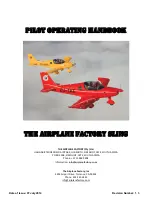
13
Version 1.0 March 2017
IMPORTANT:
•
Do practise using the speed system in normal flying.
•
Be careful flying fast in rough or turbulent conditions as deflations are more likely to occur at speed. The
speed increase is achieved by reducing the angle of attack, so the canopy has slightly more collapse
tendency.
•
Remember that your glide deteriorates at higher speeds. Best glides are achieved when the risers are level
and the brakes are off.
Check the component parts regularly for wear and tear, and ensure that the system always works smoothly.
Landing
Landing the BASE LITE is very straightforward. Flare in the normal way from an altitude of around 2 m when landing in light
winds. It may sometimes help to take wraps on the brakes to make the flare more effective.
Strong wind landings require a different technique. If you use the brakes to flare in a strong wind the BASE LITE tends to
convert this to height. This can be a real problem. The best method is to take hold of the C-risers at the maillons just before
landing, and collapse the canopy using these when you have landed. The glider will collapse very quickly using this method.
The glider can also be steered using the rear-risers but be careful not to cause a premature stall.
After landing the B-risers can also be used to collapse the canopy, although it is more difficult to control the collapsed
canopy on the ground using this method.
4 Flight Characteristics
Содержание Base LITE
Страница 1: ...1 Version 1 0 March 2017 Version 1 0 March 2017...
Страница 22: ...22 Version 1 0 March 2017 Risers...
Страница 23: ...23 Version 1 0 March 2017 Line Plan Line layout...














































